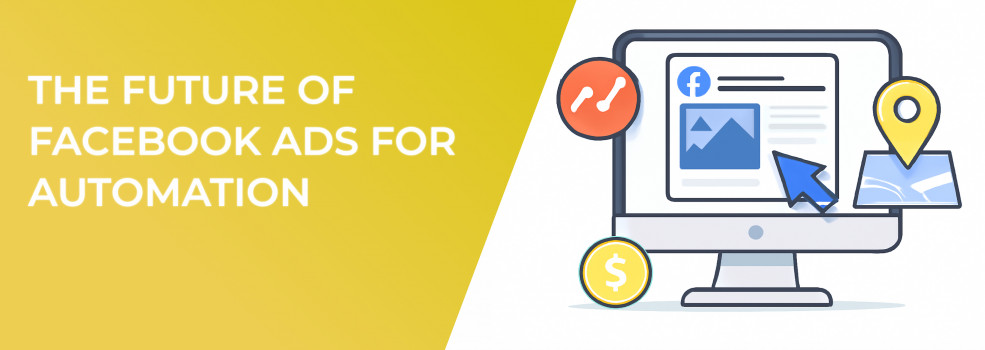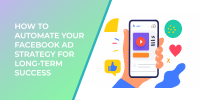Remember when running Facebook campaigns meant staring at Ads Manager every hour, nudging bids and toggling budgets? Those days are fading fast. Meta’s latest wave of automation-first ad products — from Advantage+ shopping to campaign budget optimization (CBO) — is teaching marketers a new mantra: let the machine do the heavy lifting and keep feeding it the right signals.
As automation takes the reins, marketers are realizing that it’s not about just setting up ads and walking away. Instead, it's about continuous refinement, tweaking campaigns, and feeding Meta’s algorithms the right data to get the best results. In this article, we’ll dive into how Facebook ad performance has evolved with automation and what metrics still matter. We’ll explore how automation is reshaping ad strategies and how to ensure your campaigns stay ahead of the curve.
1. The Metrics Machines Still Care About
Even the smartest algorithm needs a scoreboard to evaluate performance. These key performance indicators (KPIs) continue to be the foundation for Meta’s automation models, guiding the system to make informed decisions on your behalf. Let’s break down why these metrics matter:
-
Click-Through Rate (CTR): This tells the system how well your creative resonates with the target audience. A high CTR (above 2%) consistently ranks you in the “high relevance” category, improving your overall Facebook ad performance.
-
Cost Per Click (CPC): The lower the CPC, the more budget you have for additional impressions. Lower CPC helps the system stretch your budget to secure more conversions.
-
Cost Per 1,000 Impressions (CPM): This acts as an early warning sign if auction costs are rising, allowing you to take action before conversions dip.
-
Conversion Rate: Feeding the return-on-ad-spend (ROAS) optimization models with high conversion data enhances your campaigns' profitability.
-
Engagement Rate: A strong engagement rate pushes your ads higher in the Advantage+ creative ranking, which helps with optimization.
Here’s how these key metrics come together to ensure effective performance:
Pro-tip: Build Facebook automated reports that surface these metrics daily. This helps you catch anomalies quickly and fine-tune Meta’s algorithms for better results.
2. Advantage Campaign Budget & Beyond
The introduction of Advantage Campaign Budget (Advantage+ CBO) marked a significant shift toward automation, taking budget allocation out of the hands of manual controls. It uses real-time auction signals to shift spend between ad sets automatically, ensuring that your budget is directed to the best-performing elements. Marketers who use Advantage+ in combination with clear objectives and restrictive spend caps have seen up to 12% lift in ROAS compared to manually split budgets.
To fully harness this power, consider these tips:
-
Simplify your account structure: Avoid cluttered campaigns and allow Meta’s algorithms to learn from a broader data pool.
-
Leverage campaign budget optimization (CBO): Let the system allocate your budget based on performance, but set minimum spend floors on high-performing ad sets.
-
Monitor learning phase diagnostics: If a campaign is stuck in the "learning limited" phase, consolidate creatives or broaden your audience.
3. Signal Quality: Pixels, CAPI & Retargeting
A big part of Facebook ad optimization lies in the quality of the signals you provide. If Meta doesn’t receive accurate, actionable signals, even automation won’t perform at its best. Let’s take a look at some ways to enhance signal quality:
-
Meta Pixel: Still one of the easiest drop-in tags for tracking conversion events.
-
Conversions API (CAPI): By combining Pixel with CAPI, you send data server-side, making your signals more reliable.
-
Retargeting Pixels: While audiences are shrinking due to privacy restrictions, retargeting still performs better than prospecting campaigns, often yielding 2-3 times the ROAS.
-
Modeled Conversions: Since direct tracking is increasingly limited, modeled conversions give Meta an estimate of conversions, improving performance.
Pro-tip: Always ensure your pixels are accurately measuring events. Even small mismatches in event tracking can lead the algorithm down the wrong optimization path.
Integrating Meta Pixel, Conversions API, and retargeting strategies ensures accurate data for optimizing Facebook ad campaigns.
If your ad set is stuck with the warning 'Ad set may get zero,' it could be related to your budget settings or audience size. Learn how to troubleshoot this issue in our guide on fixing the 'Ad Set May Get Zero' error here.
4. Creative Automation: Dynamic, Not Generic
Automation is enhancing creativity rather than stifling it. It allows for more diverse testing and optimization without spending hours on manual tweaking. With tools like Dynamic Creative Optimization (DCO), Meta automatically tests different combinations of images, headlines, and body text to identify which works best for each audience. Here's how you can make the most of creative automation:
-
Dynamic Creative Optimization: Upload multiple assets (images, headlines, etc.) and let Meta test hundreds of combinations to find the best-performing ad.
-
Video Ads: Meta's auto-crop and auto-caption features let your video content adapt automatically to different formats (e.g., Stories, Reels) without editing software.
-
Multilingual Automation: Meta automatically translates your copy to scale your ads across different regions, maintaining optimization in each market.
If your Facebook ads aren’t converting despite the right signals, it might be time to revisit your tracking setup. Our guide on fixing non-converting Facebook ads can help — read it here.
5. Predictive Targeting & the End of Micro-Audiences
Advantage+ audiences represent a shift from detailed audience segmentation to more generalized, predictive targeting. Instead of obsessing over narrowly defined audience categories, let the system cast a wider net and use predictive signals to identify the best-performing audience.
Consider these strategies for effective targeting:
-
Seed broad audiences: Start with a larger audience size (10 million or more) and allow the system to narrow it down.
-
Feed high-quality conversion data: This ensures that the algorithm has the right information to perform at its best.
-
Use exclusions: Exclude existing customers or those who have already converted to avoid wasting budget.
Creative automation is enhanced with AI-driven tools, and you can learn about the best AI text and image generators to use in your campaigns here.
6. Automation & Cost Control: Myths Busted
There are plenty of myths around automation, especially when it comes to costs. Let’s debunk some common misconceptions:
-
Myth 1: Automation always increases spend.
Reality: Budget caps and ROAS targets help control costs. -
Myth 2: You lose all control with automation.
Reality: You can set up automated rules to pause ads when Facebook advertising CTR drops below your set threshold. -
Myth 3: Manual bids beat machine bids in competitive seasons.
Reality: In 2024’s Q4, Advantage+ bidding outperformed manual bids by 18% on blended ROAS across e-commerce accounts.
Debunking myths about automation, Facebook Ads’ automated rules can help control costs and improve performance.
By setting up automated rules, you gain more control than ever over your budget while leveraging machine learning’s precision.
For more in-depth insights into targeting the right audience for your Facebook campaigns, check out our article on Facebook Ad Targeting 101 here.
7. The Road Ahead: AI Agents & Predictive Budgets
Meta’s future holds even more potential with AI agents that will act as copilots inside Ads Manager. These agents will assist with campaign creation, audience forecasting, and even creative testing, making Facebook ad optimization even more intuitive.
To prepare for the future of predictive budgets and AI-driven automation:
-
Invest in data hygiene: Clean, actionable data will always yield the best results.
-
Maintain a testing mindset: Algorithms can only optimize based on data, so keep testing new creative formats, messaging, and audience strategies.
-
Stay human: Automation can’t replace the personal touch. Continue focusing on storytelling, empathy, and brand voice.
Choosing the right ad campaign objective is critical to automation’s success. If you’re unsure which objective suits your business, our article on Meta Ad Campaign Objectives offers clarity — read it here.
Conclusion
The rise of automation doesn’t signal the end of marketing creativity, it signals a new way of working smarter, not harder. By understanding and optimizing Facebook ad performance with the right signals and strategies, marketers can leverage automation to boost results. Automation is not about replacing the marketer but about enhancing their ability to drive results at scale. Ready to future-proof your campaigns? By feeding Meta’s algorithms with cleaner data, smarter budgets, and more engaging creatives, you’ll unlock new levels of success.

